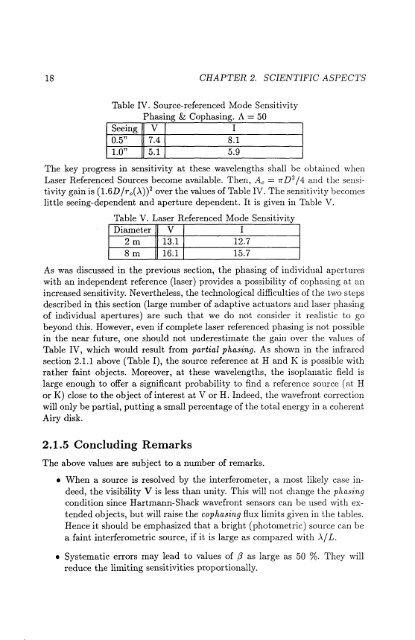The VLT Interferometer - ESO
The VLT Interferometer - ESO
The VLT Interferometer - ESO
Create successful ePaper yourself
Turn your PDF publications into a flip-book with our unique Google optimized e-Paper software.
18 CHAPTER 2. SCIENTIFIC ASPECTS<br />
Table IV. Source-referenced Mode Sensitivity<br />
Phasing & Cophasing. A = 50<br />
Seeing V I<br />
0.5" 7.4 8.1<br />
1.0" 5.1 5.9<br />
<strong>The</strong> key progress in sensitivity at these wavelengths shall be obtained when<br />
Laser Referenced Sources become available. <strong>The</strong>n, Ac = 7r D2 /4 and the sensitivity<br />
gain is (1.6D/ro(.A»2 over the values of Table IV. <strong>The</strong> sensitivity becomes<br />
little seeing-dependent and aperture dependent. It is given in Table V.<br />
Table V. Laser Referenced Mode Sensitivity<br />
Diameter V I<br />
2m 13.1 12.7<br />
8m 16.1 15.7<br />
As was discussed in the previous section, the phasing of individual apertures<br />
with an independent reference (laser) provides a possibility of cophasing at an<br />
increased sensitivity. Nevertheless, the technological difficulties of the two steps<br />
described in this section (large number of adaptive actuators and laser phasing<br />
of individual apertures) are such that we do not consider it realistic to go<br />
beyond this. However, even if complete laser referenced phasing is not possible<br />
in the near future, one should not underestimate the gain over the values of<br />
Table IV, which would result from partial phasing. As shown in the infrared<br />
section 2.1.1 above (Table I), the source reference at Hand K is possible with<br />
rather faint objects. Moreover, at these wavelengths, the isoplanatic field is<br />
large enough to offer a significant probability to find a reference source (at H<br />
or K) close to the object of interest at V or H. Indeed, the wavefront correction<br />
will only be partial, putting a small percentage of the total energy in a coherent<br />
Airy disk.<br />
2.1.5 Concluding Remarks<br />
<strong>The</strong> above values are subject to a number of remarks .<br />
• When a source is resolved by the interferometer, a most likely case indeed,<br />
the visibility V is less than unity. This will not change the pha.sing<br />
condition since Hartmann-Shack wavefront sensors can be used with extended<br />
objects, but will raise the cophasing flux limits given in the tables.<br />
Hence it should be emphasized that a bright (photometric) source can be<br />
a faint interferometric source, if it is large as compared with .AIL.<br />
• Systematic errors may lead to values of fJ as large as 50 %. <strong>The</strong>y will<br />
reduce the limiting sensitivities proportionally.

















